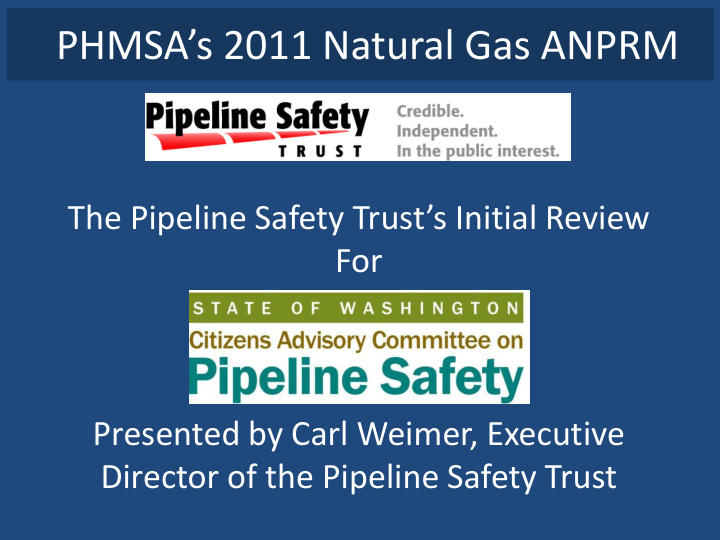



PHMSA’s 2011 Natural Gas ANPRM The Pipeline Safety Trust’s Initial Review For Presented by Carl Weimer, Executive Director of the Pipeline Safety Trust
PHMSA’s Gas ANPRM – Main Topics – A. Modifying definition of HCA – B. Strengthening requirements in HCAs – C. Modifying repair criteria – D. Improving requirements for collecting, validating, integrating pipeline data – E. Making risk modeling more prescriptive – F. Strengthening requirements for applying knowledge gained through IM – G. Improving selection and use of assessment methods – H. Valves: spacing, remote and automated
PHMSA’s Gas ANPRM – Main Topics – I. Corrosion control – J. Longitudinal Weld Seamed pipes – K. Underground Gas Storage – L. Management of Change – M. Quality Management Systems – N. Exemptions of pre-1970 pipelines – O. Modifying regulations for gas gathering lines
Topics Where the Trust is Focused – A. Modifying definition of HCA – B. Strengthening requirements in HCAs – G. Improving selection and use of assessment methods – H. Valves: spacing, remote and automated – I. Corrosion control – N. Exemptions of pre-1970 pipelines – O. Modifying regulations for gas gathering lines
NTSB Recommendations to PHMSA – Require operators to install leak detection tools – Require automatic or remote control shut off valves in HCAs and class 3 and 4 locations, appropriately spaced – Delete “grandfather clause” for pre -1970 pipes and require all pipelines constructed before 1970 to undergo a hydrostatic pressure test incorporating a spike test. – Require that all transmission lines be piggable, with priority to older lines
NTSB Recommendations Continued – Revise Integrity Management program to insure that operator metrics for risk assessment and program effectiveness are meaningful; that auditors can verify completeness and accuracy of underlying information, require review of all IM measures reported to PHMSA, compare them to operator’s risk model, set performance goals at each audit, follow up at each subsequent audit. – Work with state regulators to ensure audits employ meaningful metrics, make metrics available in centralized database, identify and correct deficiencies in oversight programs.
Major overlaps between ANPRM and NTSB Recommendations – Exemptions for pre-1970 pipeline from hydrostatic testing – Improvements in integrity management to insure metrics are useful, that valid risk assessments reflecting accurate records of systems are basis of program, and that metrics used are measurable by inspectors and shared in a common database – Automatic/remote control valves and spacing
What the Trust would like to see CCOPS encourage • Statement about the benefits of Integrity Management (IM), and the need to expand IM to all pipelines with priority being given first to protecting people within PIRs • Removal of the exemption from hydrostatic testing for pre-1970 lines • Clear standards for automated valves and spacing. • Clear inspection metrics entered into a nationwide database to measure whether operators are implementing IM properly and looking for the right risks. • Clear public metrics that allow federal regulators to identify and correct deficient state inspection programs • Better definition and regulation of gathering lines • Public availability of HCA designations and process to encourage local government to comment if they find inaccuracies
Recommend
More recommend